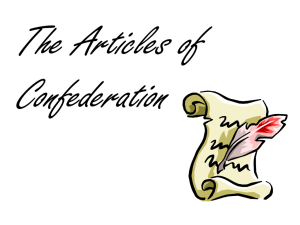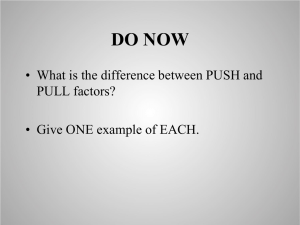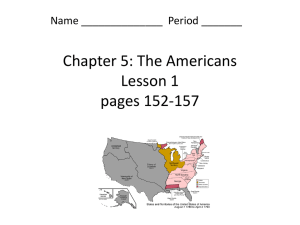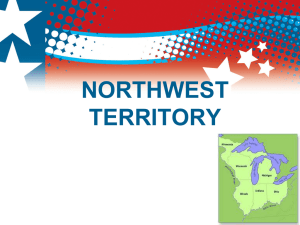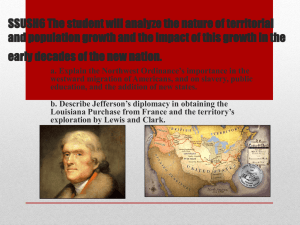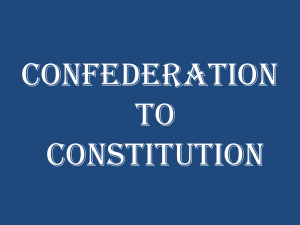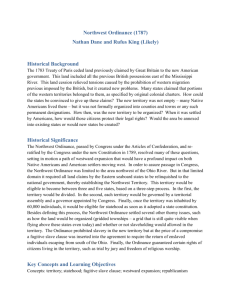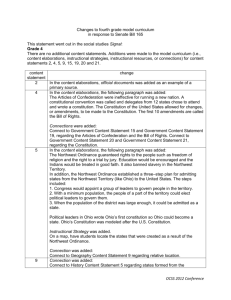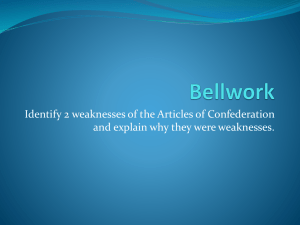Articles of Confederation: Strengths & Weaknesses
advertisement
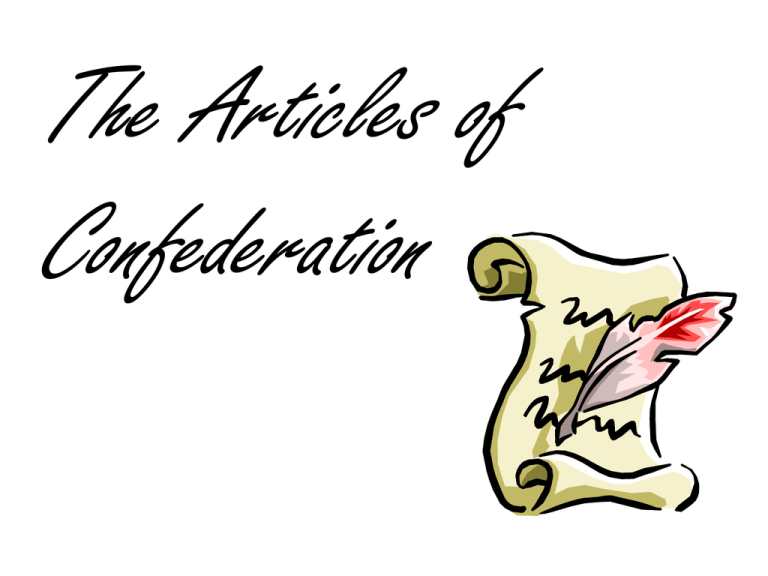
The Articles of Confederation - In 1776, Continental Congress asks states to organize their own state constitutions - States divide government between a governor and a bicameral legislature = (2 parts) (12 man council in PA) Voting = 21 year old white, male, property owners (New Jersey; women landowners vote till 1800) QUESTION: Where / with whom should power be held? ANSWER: - Power with people - Republic = citizens who rule through elected representatives Local, State, or Federal? QUESTION: What level should hold the most power? ANSWER: -Most want state level power - Concern is having too much National power (King) The Rebels needed a government to help fight the war so… the Articles allow the Federal Government to: 1) Conduct foreign affairs 2) Maintain Armed Forces 3) Issue Currency Pennsylvania Money Delaware Money 4) Borrow Money THE ARTICLES CANNOT: 1) Regulate Trade ….. Didn’t like Navigation Acts THE ARTICLES CANNOT: 2) Draft soldiers THE ARTICLES CANNOT: 3) Impose Taxes …. Didn’t like British Acts THE ARTICLES CANNOT: 4) Have a President … Don’t like having a King Speed bumps to Approval! Speed bumps to Approval! a. All 13 states had to approve them Speed bumps to Approval! b) Each state receives one vote (major Should Virginia get the argument) same number of votes as Delaware? Why or why not? Speed bumps to Approval! c) Rights to the western lands are up for grabs (Maryland) Speed bumps to Approval! -States stake claim!! Then they give it up! Speed bumps to Approval! - Finally Ratified March 1, 1781 - Articles have success! 1)It helped the United States win the Revolution 2) It helped the U. S. plan the west (1780’s) - Population west of Appalachians grows! (1,000’s to 100,000) - Jefferson proposes 10 self governing districts (petition to join) THE ORDINANCE OF 1785 Ordinance = law (for surveying, selling land) Townships - 6 mile by 6 miles Sections – 640 acres (36 total) at least a dollar (cheap!!!) -Government must protect settlers rights The Northwest Ordinance July 13, 1787, in which this invention was embodied, also consecrated the region to freedom both of conscience and of labor. It provided the model for all subsequent territories. As a political document, it ranks in our history second only to the Constitution of the Untied States. At Marietta, Ohio, on July 13, the government of the territory northwest of the Ohio was formally inaugurated. Winthrop Sargent, secretary of the territory, read the Northwest Ordinance to the New Englanders of the Ohio Company, who, at the junction of the Muskingum and the Ohio, had founded the first American City in the new region. Back of him in the mural stands Governor Arthur St. Clair, the English army officer, who had come to America to fight the French, and stayed here to fight against the English for independence. Friend of Washington, soldier and statesman of ability - in spite of his own defeat by Indians - his administration, begun on the day represented by the mural, merits everlasting remembrance. The Northwest Ordinance - Lands north of the Ohio River and east of the Mississippi River The Northwest Ordinance - Wanted 3 to 5 smaller territories - 60,000 people = application for statehood THE NORTHWEST TERRITORY The Ordinance of July 13, 1787 provided "...there shall be formed in said territory, not less than three nor more than five states..." The original boundaries were defined as: Eastern State (numbers 1,2,3,4); Middle State (numbers 5,6,7,8,9) and Western State (numbers 10,11,12,13,14,15). These divisions are marked by broken lines on the map. Congress later decided to divide the Northwest Territory into the states of Ohio (1803), Indiana (1816), Illinois (1818), Michigan (1837), Wisconsin (1848) and Minnesota (1858); as shown by the heavy solid lines on the map. -New states have “equal footing” with old Wait….There is good fur trading out there…. Why not just use that land to trade, or tax the valued trade heavily to pay off war debts? -Free religion, trial by jury, and NO SLAVERY!!! Even if the state was not here during the revolution, it will receive the same treatment as those original states. This map shows the 5 states that were created out of the Northwest Territory. ARTICLES HAVE PROBLEMS!!! 1) 9 of 13 states must approve to PASS NEW LAWS in the Articles Maryland, Massachusetts, New Jersey, North Carolina, New York, South Carolina, Delaware and Virginia may all want a law, but the 5 other states can stop them from getting it! ARTICLES HAVE PROBLEMS!!! 2) 13 of 13 states must approve to CHANGE AN OLD LAW in the Articles For Rhode Island, the Hope on the flag really meant nope in this case! 12 States can want a law CHANGED, one state (like R.I.) an stop it from happening! Change becomes a challenge! 3) FINANCIAL ISSUES: - Printed money falls in value = depreciation - Congress prints $ with no backing (gold or silver) Imagine if everyone could print money… would it be worth anything??? - Food Riots!!!!! - States give 1/6 of the money needed (Govt can’t tax) -Robert Morris’ (PA) 5% Import tax shot down (RI won’t accept) 4) PROBLEMS WITH BRITAIN - Britain won’t withdraw troops in west - George Rogers Clark keeps fighting - John Adams tries to discuss this, Britain won’t talk -Colonist have not paid loyalists for land vacated (T of P) 5) PROBLEMS WITH SPAIN Spain closes lower Mississippi to America (1784) 5) PROBLEMS WITH SPAIN - Spanish Florida / Georgia border is accepted in return for limiting American shipping 6) ECONOMIC DEPRESSION Depression = economic activity slows, unemployment rises "Leaders of the Continental Congress" by Augustus Tholey. From left to right, John Adams, Robert Morris, Alexander Hamilton, and Thomas Jefferson. As weaknesses in the Articles of Confederation became apparent, serious debate began on the benefits of a stronger national government. 6) ECONOMIC DEPRESSION - Trade slows (Britain closes West Indies to U.S.)
